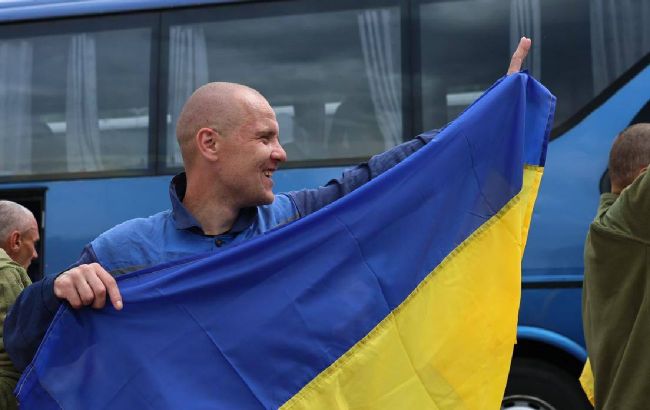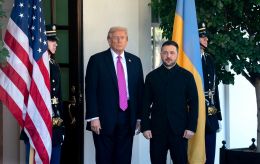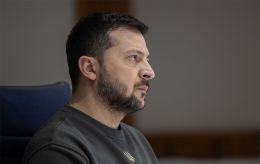New prisoner swap between Ukraine and Russia: Key details from day two (photos, video)
 Photo: Ukrainian soldier released from captivity (t.me/V_Zelenskiy_official)
Photo: Ukrainian soldier released from captivity (t.me/V_Zelenskiy_official)
Ukraine and Russia have carried out another prisoner exchange under the 1,000-for-1,000 format. This large-scale exchange, spread over three days, will be the most extensive since the start of Russia’s full-scale invasion in 2022. RBC-Ukraine provides details from the second day.
"Another 307 Ukrainian defenders are back home. Today is the second day of the 1,000-for-1,000 exchange that was agreed upon in Turkey. In just two days, 697 people have already been brought back. We expect the exchange to continue tomorrow," Ukrainian President Volodymyr Zelenskyy said.
Photo: Ukraine returns 307 more soldiers from Russian captivity (t.me/V_Zelenskiy_official)
Who returned home
According to the Coordination Headquarters for the Treatment of Prisoners of War, the Ukrainian soldiers who returned home include servicemen of the Armed Forces of Ukraine, particularly from the Air Assault Forces, the Unmanned Systems Forces, the Naval Forces, the Territorial Defense Forces, as well as from the State Border Guard Service and the National Guard of Ukraine.
For the first time, prisoners from certain units and military formations were successfully freed. In addition, 27 defenders of Mariupol were returned today.
All 307 liberated defenders are men, representatives of the private and non-commissioned staff. The youngest liberated one is 25, the oldest is 61. Among them are the wounded and sick.
Photo: Mariupol defenders return from captivity (t.me/Koord_shtab)
In total, Ukrainians who fought on the Donetsk, Kherson, Kharkiv, Zaporizhzhia, and Luhansk fronts are returning home.
How the first day of the 1,000-for-1,000 exchange went
The day before, both sides exchanged 390 people each — 270 military personnel and 120 civilians. Among those Ukraine brought back were soldiers from the Armed Forces of Ukraine, the Navy, the Air Assault Forces, the Territorial Defense Forces, the National Guard, and the State Border Guard Service.
These individuals had fought in the Donetsk, Luhansk, Kharkiv, Zaporizhzhia, and Kherson sectors, as well as in battles in the Chernihiv, Sumy, and Kyiv regions. After the exchange, they will undergo medical check-ups and receive all necessary assistance. Some had been in captivity for more than three years — since 2022. For example, marines from the 36th Brigade who defended Mariupol.
Defense Minister Rustem Umerov noted that the exchange lists were formed "according to a single criterion — to save lives."
"Primarily, this exchange involved prisoners of war and civilians. We are working with all categories, with all branches of the Defense Forces, which is why they are included. And we are working to complete the first phase. That's 1,000 people," the minister said in response to a question about whether captured Azov fighters would be included in the major exchange.
More details about yesterday’s events are available in the article “They’re home: exclusive report by RBC-Ukraine from the largest exchange (photos, video).”
Who Ukraine handed over during the May 23 exchange
In addition to Russian prisoners of war, dozens of collaborators were transferred. These were mostly convicted Ukrainian citizens who had worked for the enemy. President Volodymyr Zelenskyy confirmed earlier that the exchange pool is being replenished in part through this category.
According to the project "I want to return home" (implemented by the Coordination Headquarters for the Treatment of Prisoners of War with the support of the Defense Intelligence, the Security Service of Ukraine, and the Ombudsman), 70 people were sent to Russia yesterday in exchange for Ukrainian hostages. Profiles of around 30 collaborators are listed on the "I want to return home" website, marked "departed."
Among them is Oleksandr Tarnashynskyi, an ally of Viktor Medvedchuk and one of the leaders of the pro-Russian organization "Ukrainian Choice." Also transferred were Vasyl Mekheda, a former Cabinet Secretariat official who had passed classified data to Russia since 2006, and Vitaliy Vasyliev, a former officer of the SSU office in Luhansk.
How the 1,000-for-1,000 exchange came about
This exchange resulted from the first direct talks between Ukraine and Russia in three years, held in Istanbul (Türkiye) on May 16. It is effectively the only concrete outcome of that meeting. It is expected that, following the exchange, the Russian side will present a draft “memorandum” on a ceasefire. Ukraine will provide its remarks, and the next round of talks will focus on the potential for a ceasefire.
The Istanbul meeting lasted several hours. Later, participants confirmed that the Russian delegation issued unrealistic ultimatums, including threats to "fight indefinitely" and capture additional regions. According to CNN, Turkish mediators proposed the large-scale exchange as a way to steer the talks back in a constructive direction.

